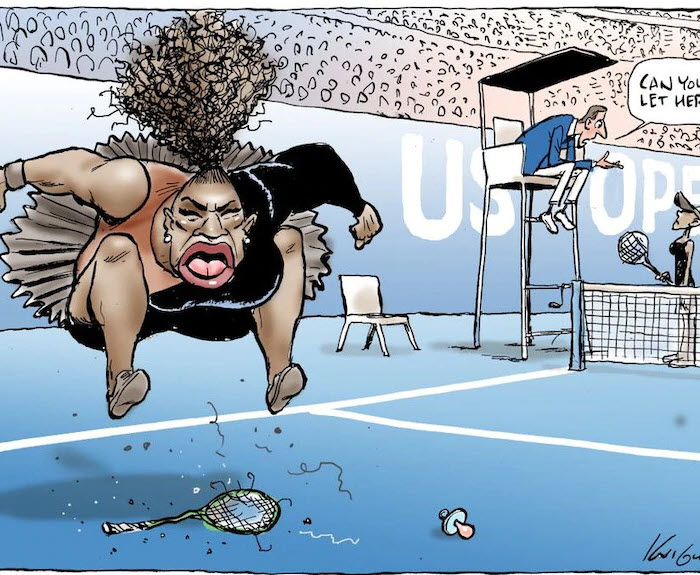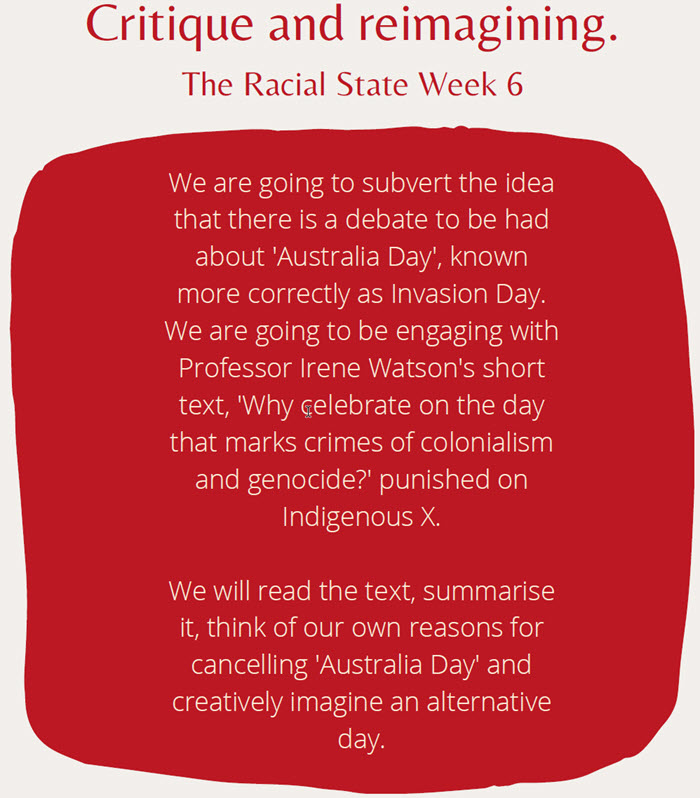Ashleigh Barty’s Wimbledon victory reminded me of an incident several years ago involving another top tennis player, Serena Williams.
In case you don’t remember, at the US Open in September 2018 Williams threw an ugly temper tantrum in response to a decision by the umpire in a match she lost to Naomi Osaka. This behaviour cast a pall over the match, with Osaka (a person of mixed race) reduced to tears by booing during the trophy presentation ceremony.
Unsurprisingly there was widespread criticism of William’s appalling conduct, and that, in a sane world, would be where the matter should have ended. What transformed it into a racial issue, at least in the eyes of those subject to the mind virus that is Critical Race Theory (CRT), was the publication in the Melbourne Herald-Sun of a cartoon by their resident cartoonist Mark Knight that caricatured Williams, a heavily built black woman as, well, a heavily built black woman throwing a temper tantrum. What else is a cartoonist supposed to do?

This immediately triggered charges of racism, and a global twitterstorm. The charge of racism was patently absurd, and the cartoonist and some others argued accordingly. To suggest otherwise would be to effectively place all non-white people, irrespective of their power, privilege and public profile beyond the reach of caricature. An intolerable restraint on freedom of speech.
Mark Knight was subjected to a torrent of vilification, including threats of violence to himself and his family serious enough to warrant hiring security guards for his home.
You would think all reasonable people could accept that the matter is, at the very least, debatable. But not to critical race theorists like Western Sydney University associate professor Alana Lentin.
Indeed, Lentin insisted that to suggest it could be debated was itself racist. She even had to upbraid ABC Radio Adelaide:
Unfortunately, the ABC fell into the very trap I was pointing out in the article by setting the conversation up as a supposedly ‘balanced’ debate between myself and a right-wing journalist who found ‘nothing racist’ about the cartoon. Once I expressed to the journalist that I had no intention of discussing whether or not the cartoon was racist, she cut me off and turned to the other interviewee to wax lyrical about how this was nothing to do with historical racist caricature!
How triggering, for Ms Lentin to be expected to actually debate the issue with a ‘right-wing journalist’. In an article in the Guardian Lentin rejects the very idea that a claim of racism like this can be debated:
The supposed debatability of racism is why it is possible for Knight to deny his cartoon is racist despite countless people, black women in particular, around the world saying that it is.
How convenient. To avoid the bother of having to persuade people of the truth of your accusation in the face of contrary arguments, just declare the issue “not debatable”! According to Woke epistemology, all that matters is the subjective perceptions of the alleged victims—or, at least, those members of the victim class who share the CRT ideological perspective.
This is truly sinister stuff, especially now that claims of racism have been given legal teeth so that, even if a claim of racism is not upheld in a court, a person can be dragged through a protracted, stressful and very expensive legal process (as with the Bill Leak case, and the QUT students case).
This “non-debatability” theme recurs in Lentin’s scholarship. For example, take a look at this recent (19 July) slide illustrating an "Invasion Day exercise", part of a program of exercises on “The Racial State”. Notice how this piece of “scholarship” does not open a debate about Australia Day, but seeks to “subvert the idea that there is a debate to be had about ‘Australia Day’, known more correctly as Invasion Day”.
The students are expected to “read the text, summarise it, think of our own reasons for cancelling ‘Australia Day’ and creatively imagine an alternative day”. Not debate the matter in an open manner—think up additional reasons to back the predetermined, non-debatable position.

Who is the audience for this? Presumably Lentin’s own students, but disturbingly Lentin mentions that one of the exercises was delivered to medical students at Sydney University.
As many have noted, CRT is becoming all pervasive throughout all levels of education, government, media and the corporate sector, especially in the US where it has even penetrated top levels of the military. Check out the video below of Chairman of the Joint Chiefs of Staff, General “Thoroughly Modern” Milley.
Alana Lentin is, I gather, the leading practitioner in Australia of this new quasi-religion. Religion? That’s surely an exaggeration? Well consider this episode of the ABC Radio National Program The Minefield titled Wrong to be White that featured Lentin and Deakin University historian Joanna Cruikshank. The compere was Scott Stephens, who runs the ABC’s religion and ethics website, who soared to this giddy height of ethno-masochism as the two academics murmured their assent:
The great moral debility about being white is that people have wilfully chosen the trinkets and accoutrements of the accretions of power and privilege over a much more fundamental bondedness with other human beings … I mean that is, if we were speaking in a theological register we would call that a tremendous or even radical sin.
So, you see, white people are just plain bad, just miserable sinners according to these Calvinist fundamentalists of identity politics, predestined to a lifetime devoted to expiating their inherited guilt, with the only hope of redemption being accepted as a loyal “ally” of the oppressed, though even this is doubtful: (on her website Lentin announced she had been asked to go on the program to talk about the irredeemable nature of whiteness.
How did progressivism, which decades ago would happily identify with Enlightenment rationalism, mutate into this?